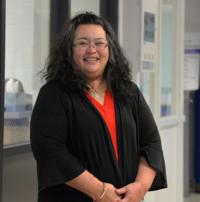BOLD STEP — Bethel Middle Principal Shawn Parris banned cell phones from bell-to-bell at the start of the school year. Phones must be turned off and can’t be taken out of students’ book bags from the morning bell until dismissal.
BETHEL — A middle school in Haywood County took the bold step this year of banning cell phones from bell to bell, and it’s made all the difference.
“They communicate with each other more face-to-face now,” said Shawn Parris, principal of Bethel Middle.
Surprisingly, there’s been no backlash over the phone ban. Parris thinks parents are relieved by it since they’re unable to monitor their kids’ device use while at school.
“These kids are our kids while they’re here. We want to take care of them the same we we’d take care of one of our own at home,” Parris said.
As smart phones swept through society at lightning pace, they permeated teen culture before schools knew what hit them. A mounting number of studies on how smart phones impact education have concluded that smart phones are not merely a distraction but rise to the level of attachment and addiction disorders for some youth — and quite obviously are interfering with learning.
Haywood County Schools doesn’t have a hard-and-fast policy of when phones are allowed and when they’re not. Officially, phones can’t create a disruption during instructional time, but it’s up to each school to decide what constitutes a disruption.
Most middle and high schools allow phones to come out in the hallway or at lunch. But all too often, the social media posts flying during class changes spill into the classroom once students take their seats — and in Parris’ book, that qualified as a disruption during instructional time.
“We decided that was still too much,” Parris said.
Without an outright ban, phones became a slippery slope, with students sneaking a peak in their book bags, pockets or under their desk.
“We are just taking that temptation away,” she said.
Barbara Tracy, mom of a sixth grader at Bethel Middle, is very happy about the phone ban in school.

She’s had the unique experience of raising children in both worlds. Her oldest, now 30, didn’t have to deal with the pressures of a smart phone in their pocket.
“Back then it was the flip phones. You didn’t have to worry about Facebook,” she said.
Her middle child came of age during the advent of the smart phone era and taming device use was a constant battle.
“It was a struggle,” Tracy said. “He said, ‘Well everybody is doing it, and I said, ‘Just because somebody else is allowed to do it, we’re not other families.’”
Now, with her sixth grader, she’s still holding firm.
“When he is ready to go out on his own, he has to know how to properly interact with society because this is not going to go away,” she said.
National movement
Tracy isn’t alone. A nationwide movement is underway to put the horse back in the barn. Responsible smart phone and social media use is now being taught in schools, and at a younger age than ever before. Bans like the one at Bethel Middle are becoming more common.
There’s hope that the next generation of students will be spared from the ill-effects that the first generation of smart-phone wielding teens had to suffer through.
“It is getting instilled in them at a younger age so when they get to high school they are more aware of the situation,” Parris said.
Parris shared an enlightening anecdote about an multi-day overnight field trip last year. Students could use their phones at will, except during one evening outing to go bowling.
When surveyed about the trip and asked what their favorite part was, students overwhelming said the night of bowling was the best part. Parris doesn’t think it’s a coincidence that it was the device-free night.
Parris offered some advice for parents struggling with the right balance of how much to monitor their kids’ phone and internet use. Parents intrinsically want to trust their teen and afford them a level of privacy.
But it’s OK to keep tabs on your child’s internet and social media use, Parris said.
“The best thing you can do is randomly walk in to their room and check your child’s social media accounts,” Parris said. “It’s like checking their homework.”
Parents should also use the same social media platforms as their kids and follow or friend them.
No comments:
Post a Comment